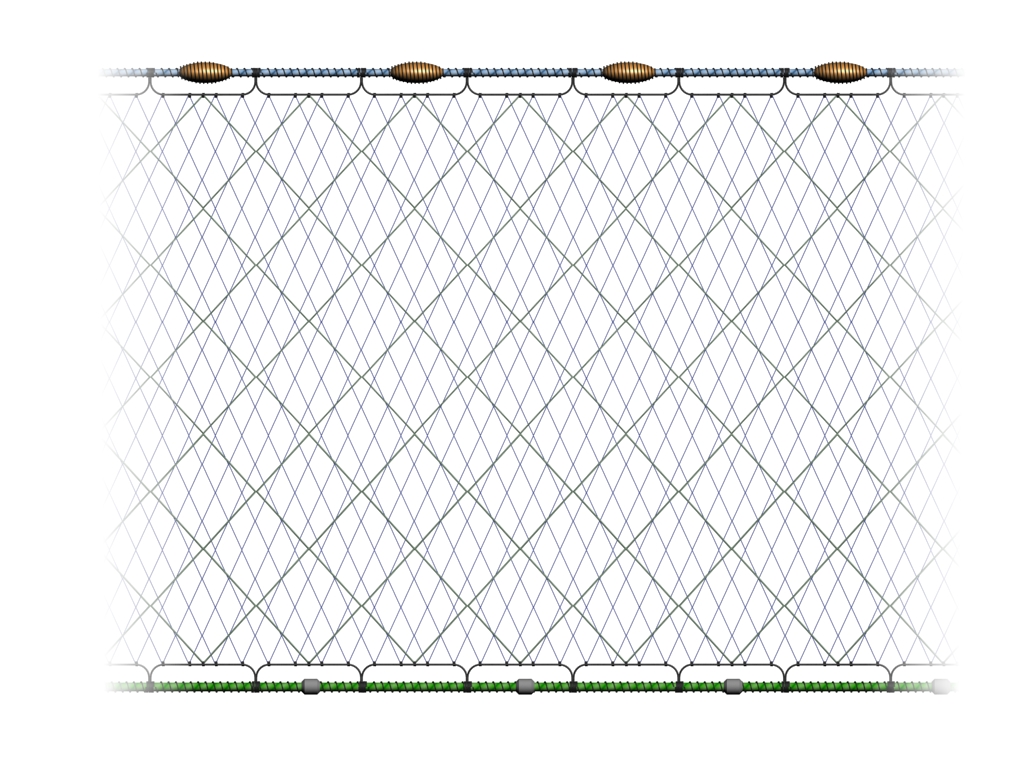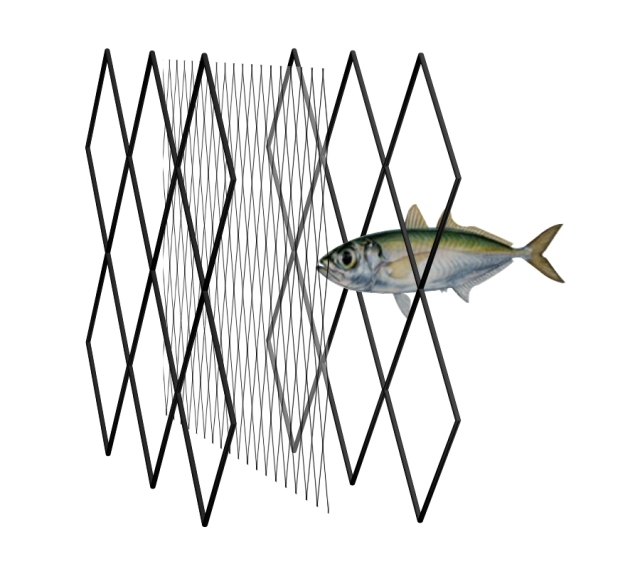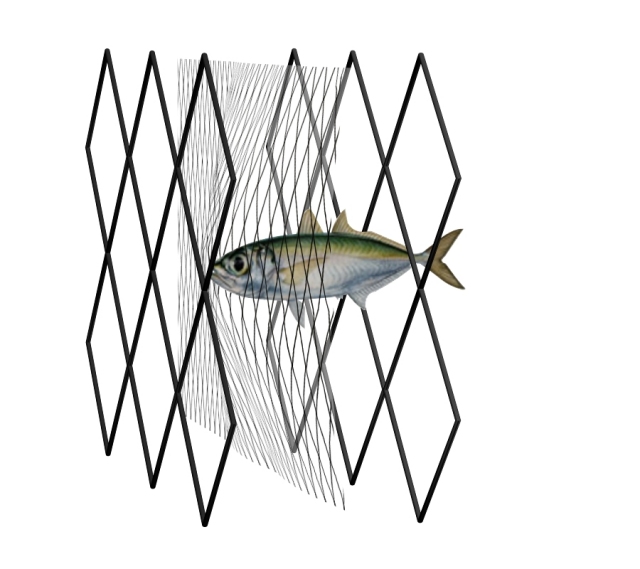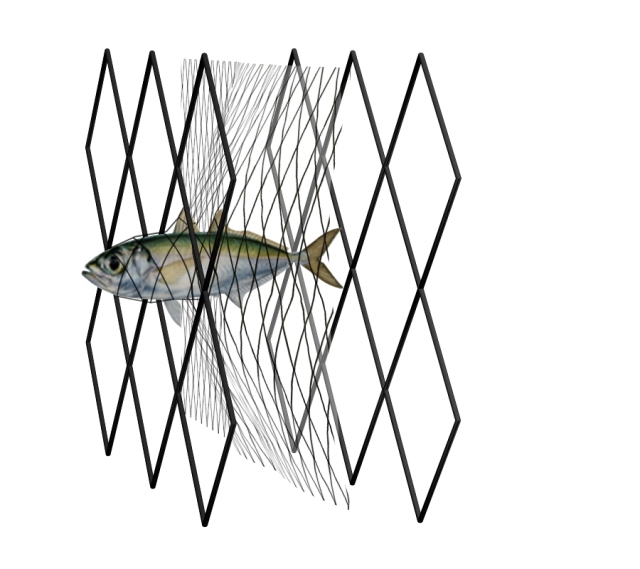Trammel Nets
Summary
Trammel nets are similar to a gill net but are made up of three layers of netting. In UK waters they are generally set on or close to the seabed to target demersal fish. In some overseas fisheries they may be set in mid water or just below the surface to target pelagic fish.

Environmental impact
Compared to gill nets, trammel nets sometimes show poorer selectivity because of the tangling characteristics of the three layers of netting compared to the single layer of a gill net. By-catch is usually minimised by the skippers knowledge of the grounds and by him shooting his gear where he expects there to be an abundance of the target species with minimum by-catch.
In some areas there can be problems with cetacean by-catch, but in most fisheries the skippers are already aware of this and have adopted the use of acoustic pingers to keep the cetaceans away from the gear. Seabed contact with trammel nets is limited to very light contact from the footrope and minimal contact from the small anchors at each end. These will penetrate the seabed but will have minimum, if any ploughing effect on the seabed, only moving when the gear is hauled. As the gear is not towed over the seabed there should be very little abrasion.
Occasionally there may be problems with ‘ghost fishing’. This is where the nets are lost and continue fishing for some time after they are lost. There have been attempts to mitigate this by encouraging fishermen to report lost gear so that it can be retrieved at a later date. It has also been found that lost nets will very quickly get entangled with weed and become visible to the fish and eventually sink to the seabed.
Other information
Trammel nets are similar to a gill net but are made up of three layers of netting. Two outer layers of large mesh with a sheet of fine small mesh sandwiched between them. The inner layer of small mesh netting is hung onto the headline and foot rope much slacker that the outer two layers, it is also made much deeper than the two outside layers. This creates plenty of slack netting that the fish swim into and get tangled in pockets of netting between the two outer layers. Trammel nets are found to be more efficient at catching broad selection of species and size of fish than a gill net.



The procedure used when fishing fixed nets is similar whether gill, trammel or tangle nets are being used. The nets are usually fished in groups (or fleets as they are widely known) with the end of each fleet attached by bridles to a heavy weight or anchor on the seabed. Each weight or anchor is secured to a marker buoy or dhan flag on the surface by a length of rope equal to about twice the depth of water. Depths of water fished can be from 15 metres to 140 meters, with some fisheries going as deep as 1800 metres (deep-water monk and tangle nets).
Length of nets can vary from 50 metres to 200 metres and length of fleets from 300 metres to 2000 metres. The amount of netting being fished (set on the seabed) at any one time can range between 2 kilometres and 30 kilometres and soak times (the time a fleet is left on the seabed to fish) can range from a 6 hour tidal soak to 72 hours. These figures are dependent on which species are being targeted and whether there is any conflict with other boats using mobile fishing gear in the area.
The nets are shot whilst steaming into the tide and are fished along the direction of the tidal stream, rather than across it (there are some exceptions to this). This reduces the chances of the nets being swept over or tangled in the strong tidal conditions found in many areas of the UK. The dhan is thrown overboard and the vessel steams away from it paying out the rope until it reaches the anchor which is quickly dropped overboard. The fleet of nets follows until the full length of netting has run out and the second anchor and dhan follow.
Retrieval of the gear is carried out in the same order with first the dhan, then the anchor and net followed by the remaining anchor and dhan. Virtually all boats now use net haulers to help them retrieve the gear. The basic design consists of a rotating drum covered with rubber, which is driven by a hydraulic system run off the main engine. The rubber grips the net, allowing the hauler to take the strain of the net and pull it aboard. Variations on the basic design include belts or rubber spheres, which exert pressure on top of the netting creating more friction with the lower drum and the netting making it easier to haul the net.
The procedure used when fishing fixed nets is similar whether gill, trammel or tangle nets are being used. The nets are usually fished in groups (or fleets as they are widely known) with the end of each fleet attached by bridles to a heavy weight or anchor on the seabed. Each weight or anchor is secured to a marker buoy or dhan flag on the surface by a length of rope equal to about twice the depth of water. Depths of water fished can be from 15 metres to 140 meters, with some fisheries going as deep as 1800 metres (deep-water monk and tangle nets).
Length of nets can vary from 50 metres to 200 metres and length of fleets from 300 metres to 2000 metres. The amount of netting being fished (set on the seabed) at any one time can range between 2 kilometres and 30 kilometres and soak times (the time a fleet is left on the seabed to fish) can range from a 6 hour tidal soak to 72 hours. These figures are dependent on which species are being targeted and whether there is any conflict with other boats using mobile fishing gear in the area.
The nets are shot whilst steaming into the tide and are fished along the direction of the tidal stream, rather than across it (there are some exceptions to this). This reduces the chances of the nets being swept over or tangled in the strong tidal conditions found in many areas of the UK. The dhan is thrown overboard and the vessel steams away from it paying out the rope until it reaches the anchor which is quickly dropped overboard.
The fleet of nets follows until the full length of netting has run out and the second anchor and dhan follow. Retrieval of the gear is carried out in the same order with first the dhan, then the anchor and net followed by the remaining anchor and dhan. Virtually all boats now use net haulers to help them retrieve the gear. The basic design consists of a rotating drum covered with rubber, which is driven by a hydraulic system run off the main engine. The rubber grips the net, allowing the hauler to take the strain of the net and pull it aboard. Variations on the basic design include belts or rubber spheres, which exert pressure on top of the netting creating more friction with the lower drum and the netting making it easier to haul the net.
Gear classification
Main target species (UK)
-
- Brill
- Cod
- Dover Sole
- Flats
- Haddock
- Hake
- Monkfish
- Pollack (Lythe)
Possible bycatch
-
- Any demersal species
- Crabs
- Occasional cetaceans and mammals